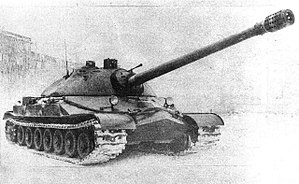IS-7 (tank)
| IS-7 | |
|---|---|

Soviet IS-7 |
|
| General properties | |
| crew | 5 (commander, driver, gunner, two loaders) |
| length | 10.00 m (7.38 m tub) |
| width | 3.40 m |
| height | 2.48 m |
| Dimensions | 68 tons |
| Armor and armament | |
| Armor | 20 mm (floor) to 216 mm (tower) |
| Main armament | 1 × 130 mm S-70 tank cannon |
| Secondary armament | 2 heavy 14.5 mm machine guns KPWT 6 machine guns SGMT |
| agility | |
| drive | V12 four-stroke diesel engine M50T 1,050 PS (772 kW) |
| suspension | Torsion bar suspension |
| Top speed | 55 km / h (road), 32 km / h (terrain) |
| Power / weight | 15.4 hp / t |
| Range | 300 km |

The IS-7 (from I ossif S talin; German Josef Stalin or Object 260 ) was a heavy Soviet tank of the IS series , which was designed as the successor to the IS-3 shortly after the Second World War . The IS-7 is the heaviest tank ever built in the Soviet Union .
development
The model was developed in KB LKW ( Leningrader Kirowwerk ) under the direction of Nikolai Fyodorowitsch Shaschmurin . The director and chief designer of the design office was Sh. Yes. Cotine. Only six prototypes were produced between 1946 and 1949. The dimensions of the IS-7 corresponded roughly to that of the German Tiger II from World War II; with significantly stronger armor and a much larger caliber of the main weapon. While the Tiger II was clearly underpowered with 10 HP / t, the IS-7 had a power to weight ratio of over 15 HP / t, which gave it sufficient maneuverability. Due to the high total mass, the tank could only pass a few of the bridges of that time. Since the trend after the Second World War was towards lighter tanks, the IS-7 was not produced in series and instead the T-10 was developed, with which the era of heavy tanks also ended in the Soviet Union. All subsequent models were lighter, faster and more agile. The IS-7 was the last tank named after Josef Stalin .
The first two prototypes were completed on December 8th and 25th, 1946.
Armament
Like the other tanks in the IS series from the IS-2 onwards , the IS-7 had a muzzle brake , which was otherwise unusual in Soviet tanks. The S-70 cannon was developed from the 130 mm B-13 naval gun from 1935 and already had a stabilizer and a semi-automatic loader. The combat rate was 25–28 rounds, and the ammunition was in two parts like the IS-2. Outside of the Navy, this cannon was only used in the IS-7 and in the only prototype of the Object 263 self-propelled gun . The maximum firing range was 27 km, the muzzle velocity 900 m / s and the mass of the projectiles was 33.4 kg.
The IS-7 had strong secondary armament with a total of eight machine guns. A KPWT was arranged next to two SGMTs coaxially to the cannon, a KPWT was mounted on the tower as an anti-aircraft machine gun. Two machine guns were mounted on each side in the hull and turret. The SGMT were all remote controlled. The KPWT's combat unit consisted of 1,000 14.5 × 114 mm cartridges , while the SGMT carried 6,000 7.62 × 54 mm R cartridges .
engine and gears
The engine was a V12 four-stroke diesel engine derived from a marine diesel. A 6-speed planetary gear was used for power transmission (8 forward and two reverse gears).
landing gear
The IS-7 was the first heavy Soviet tank to have a roller mechanism with large rollers instead of a support roller drive. Its ground specific pressure was 0.90 kg / cm². The climbing ability was 30 °, the fording ability 1.50 m and the ground clearance 45 cm.
Model variants
Two self-propelled gun prototypes were built on the basis of the IS-7:
- Object 261 with cannon 152 mm
- Object 263 with cannon 130 mm
literature
- AW Karpenko: Soviet-Russian tanks . 1905-2003. Ed .: Rudi Meier. Elbe-Dnjepr, Klitzschen 2004, ISBN 3-933395-44-5 , p. 426 (491 pp., Russian: Обозрение отечественной бронетанковой техники (1905–1995 гг.) . Translated by Rudi Meier).
Footnotes
- ↑ a b c A. W. Karpenko: Soviet-Russian tanks . 1905-2003. Ed .: Rudi Meier. Elbe-Dnjepr, Klitzschen 2004, ISBN 3-933395-44-5 , p. 426 (491 pp., Russian: Обозрение отечественной бронетанковой техники (1905–1995 гг.) . Translated by Rudi Meier).
- ↑ a b Опытный тяжёлый танк ИС-7 (IS-7 heavy tanks). In: русская-сила.рф. Retrieved August 30, 2016 (Russian).
- ↑ a b PKKA-CA: IS-7. In: pkka.narod.ru. Accessed August 30, 2016 .
Web links
- ИС-7. In: armor.kiev.ua. Retrieved August 30, 2016 (Russian).